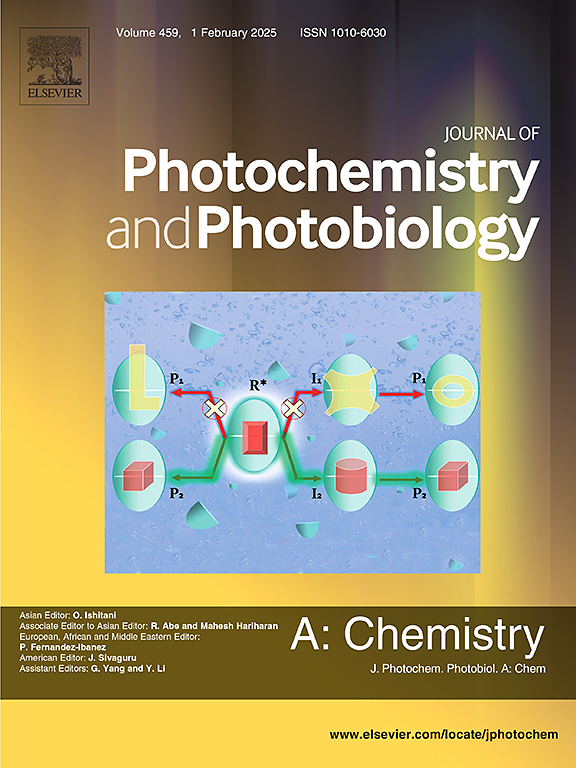Tetracyanobutadiene- and dicyanoquinodimethane-functionalized D′-A-(π)-D-(π)-A-D′ type indacenodithiophene small-molecule chromophores: Synthesis, optoelectronic properties and photovoltaic response
IF 4.1
3区 化学
Q2 CHEMISTRY, PHYSICAL
Journal of Photochemistry and Photobiology A-chemistry
Pub Date : 2025-03-10
DOI:10.1016/j.jphotochem.2025.116376
引用次数: 0
Abstract
Tetracyanobutadiene (TCBD) and dicyanoquinodimethane (DCNQ)-functionalized π-conjugated small-molecule chromophores (SMCs) have received continuous attention in organic optoelectronic devices. Herein, four D′-A-(π)-D-(π)-A-D′ type SMCs (IDT-PCN, IDT-TCN, IDT-T-PCN, and IDT-T-QPCN) based on TCBD/DCNQ were designed and synthesized by strategically changing A and D′ groups and inserting π-bridge to investigate of their molecular structures, optical and electrochemical properties and other functional properties. These symmetrical SMCs were easily obtained through shorter reaction steps relative to unsymmetrical molecules. Results demonstrated that the end-capped D′ (benzene and thiophene) has a limited effect on molecular structures and optoelectronic properties, whereas the the insertion of π-bridge (thiophene) and change of A unit (TCBD versus DCNQ) can evidently redshift absorption spectra, reduce optical bandgaps (Egopt) and lower HOMOs. As a result, IDT-PCN and IDT-TCN exhibit similar absorption spectra and Egopt as well as HOMO/LUMOs; in contrast, for IDT-T-QPCN, the most redshifted absorption band, narrowest Egopt (1.16 eV) and highest-lying HOMO/LUMOs are obtained. Theoretical calculations indicate these D′-A-(π)-D-(π)-A-D′ molecules possess a good planar geometry along the main conjugated molecular backbone, facilitating effective π-electron delocalization and strong ICT effect from the D to A units; while the end-capped D′ and far = C(CN)2 group are almost orthogonal with the main conjugation backbone. Moreover, the photovoltaic response of these new SMCs was evaluated by fabricating binary and ternary organic solar cells (OSCs). Results reveal that both PBDB-T:SMC and SMC:PC71BM binary systems produced rather poor device efficiencies (below 1 %). Inspiringly, compared to the control PM6:Y6 binary device, the PM6:Y6:IDT-T-PCN ternary OSCs with IDT-T-PCN as the third component showed enhanced photostability and an obviously improved efficiency (17.36 %), the highest for TCBD-based active materials. On a larger picture, this finding argues the influence of the A group and π-bridge on manipulating the optoelectronic properties of TCBD/DCNQ-based D′-A-(π)-D-(π)-A-D′ chromophores and the application potential of these SMCs in constructing efficient ternary OSCs, which opens more avenues for the rational development of TCBD/DCNQ-based SMCs for efficient OSCs and other optoelectronic applications.

求助全文
约1分钟内获得全文
求助全文
来源期刊
CiteScore
7.90
自引率
7.00%
发文量
580
审稿时长
48 days
期刊介绍:
JPPA publishes the results of fundamental studies on all aspects of chemical phenomena induced by interactions between light and molecules/matter of all kinds.
All systems capable of being described at the molecular or integrated multimolecular level are appropriate for the journal. This includes all molecular chemical species as well as biomolecular, supramolecular, polymer and other macromolecular systems, as well as solid state photochemistry. In addition, the journal publishes studies of semiconductor and other photoactive organic and inorganic materials, photocatalysis (organic, inorganic, supramolecular and superconductor).
The scope includes condensed and gas phase photochemistry, as well as synchrotron radiation chemistry. A broad range of processes and techniques in photochemistry are covered such as light induced energy, electron and proton transfer; nonlinear photochemical behavior; mechanistic investigation of photochemical reactions and identification of the products of photochemical reactions; quantum yield determinations and measurements of rate constants for primary and secondary photochemical processes; steady-state and time-resolved emission, ultrafast spectroscopic methods, single molecule spectroscopy, time resolved X-ray diffraction, luminescence microscopy, and scattering spectroscopy applied to photochemistry. Papers in emerging and applied areas such as luminescent sensors, electroluminescence, solar energy conversion, atmospheric photochemistry, environmental remediation, and related photocatalytic chemistry are also welcome.

 求助内容:
求助内容: 应助结果提醒方式:
应助结果提醒方式:


